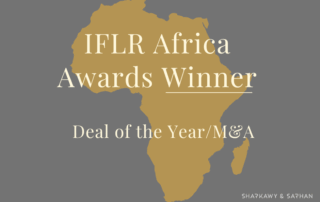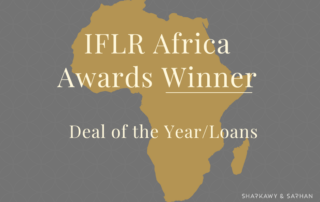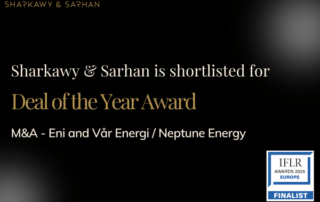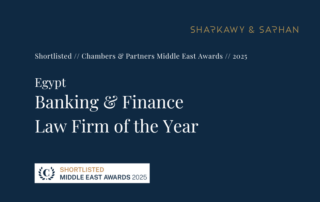13th of March, 2015
Egypt Issues New Law Incentivizing Renewals: First Round of Feed-in Tariff Qualifications Announced
Keywords: Infrastructure & Projects, Banking & Finance
On the 21st of December 2014, Egypt issued a new law on incentivizing power generation from renewable sources in Egypt (the “Law”).
According to the Law, projects for generation of power from renewable sofor investors to construct, own, and operate renewable energy power plants. EETC would offtake all the power generated by these plants at the price to be agreed with the investor (without adhering to a feed-in tariff).
1- Tenders by the EETC ed power to EETC and distribution companies through offtake agreements at a set price (the feed-in tariff)
2- Investors may construct, own and operate renewable energy power plants and sell the generaturces may be created, among others, as follows:
3- Investors may also independently construct renewable energy power plants and directly enter into agreements with consumers to sell power generated from renewable sources. We expect, however, that the prices under this arrangement will be subject to approval from the Egyptian Electric Utility and Consumer Protection Regulatory Agency (ERA).
According to article 5 of the Law, the ERA issues licenses to producers and sellers of power generated from renewable sources. Investors who build renewable energy power plants with a capacity of over 500 kW must incorporate a Project Company in the form of a joint stock company under law 8 of 1997 (the Investment Law) to implement the project and hold such licenses.
Power producers who generate power for their own consumption only, and renewable energy power plants with a capacity of 500 kW or less, are exempted from this licensing requirement.
According to article two of the Law, government land for renewable energy projects may be allocated under a usufruct arrangement with the annual usufruct fee priced at the value of two percent of the electricity produced. The government will not bear difference between the feed-in tariffs and the prevailing power prices, but will rather apply “Renewable Portfolio Standards” by mandating certain categories of consumers (as determined annually by the Cabinet of Ministers) to purchase certain quotas of renewable power at the feed-in applicable tariffs.
Finally, regarding the cost of connection to the national electricity grid, article six of the Law states that EETC or the relevant distribution company, as the case may be, shall bear the costs of connecting renewable energy plants to the national grid. If EETC or the relevant distribution company is unable to connect such plants to the grid, it shall purchase the power produced from such plants in accordance with the rules to be issued by the ERA in this regard.
First round of Feed-in Tariff qualifications announced.
Implementation of the recently introduced regime for feed-in tariffs in Egypt referred to under 2 above is already underway. Investors wishing to implement projects under the feed-in program must be qualified by the ERA first. Qualified bidders for the first round were announced last week. Twenty-eight companies were qualified for wind energy projects, and sixty-nine were qualified for solar energy projects with a capacity above 50 MW. (A list of qualified companies can be found here.)
No date for the second round for qualifications has been set yet. We do not expect this to take place soon, as we understand the government received in the first round significantly more requests for qualifications than originally expected.
According to the Law, projects for generation of power from renewable sofor investors to construct, own, and operate renewable energy power plants. EETC would offtake all the power generated by these plants at the price to be agreed with the investor (without adhering to a feed-in tariff).
1- Tenders by the EETC ed power to EETC and distribution companies through offtake agreements at a set price (the feed-in tariff)
2- Investors may construct, own and operate renewable energy power plants and sell the generaturces may be created, among others, as follows:
3- Investors may also independently construct renewable energy power plants and directly enter into agreements with consumers to sell power generated from renewable sources. We expect, however, that the prices under this arrangement will be subject to approval from the Egyptian Electric Utility and Consumer Protection Regulatory Agency (ERA).
According to article 5 of the Law, the ERA issues licenses to producers and sellers of power generated from renewable sources. Investors who build renewable energy power plants with a capacity of over 500 kW must incorporate a Project Company in the form of a joint stock company under law 8 of 1997 (the Investment Law) to implement the project and hold such licenses.
Power producers who generate power for their own consumption only, and renewable energy power plants with a capacity of 500 kW or less, are exempted from this licensing requirement.
According to article two of the Law, government land for renewable energy projects may be allocated under a usufruct arrangement with the annual usufruct fee priced at the value of two percent of the electricity produced. The government will not bear difference between the feed-in tariffs and the prevailing power prices, but will rather apply “Renewable Portfolio Standards” by mandating certain categories of consumers (as determined annually by the Cabinet of Ministers) to purchase certain quotas of renewable power at the feed-in applicable tariffs.
Finally, regarding the cost of connection to the national electricity grid, article six of the Law states that EETC or the relevant distribution company, as the case may be, shall bear the costs of connecting renewable energy plants to the national grid. If EETC or the relevant distribution company is unable to connect such plants to the grid, it shall purchase the power produced from such plants in accordance with the rules to be issued by the ERA in this regard.
First round of Feed-in Tariff qualifications announced.
Implementation of the recently introduced regime for feed-in tariffs in Egypt referred to under 2 above is already underway. Investors wishing to implement projects under the feed-in program must be qualified by the ERA first. Qualified bidders for the first round were announced last week. Twenty-eight companies were qualified for wind energy projects, and sixty-nine were qualified for solar energy projects with a capacity above 50 MW. (A list of qualified companies can be found here.)
No date for the second round for qualifications has been set yet. We do not expect this to take place soon, as we understand the government received in the first round significantly more requests for qualifications than originally expected.

Egypt Issues New Law Incentivizing Renewals: First Round of Feed-in Tariff Qualifications Announced
13 March, 2015
Keywords: Infrastructure & Projects, Banking & Finance
On the 21st of December 2014, Egypt issued a new law on incentivizing power generation from renewable sources in Egypt (the “Law”).
According to the Law, projects for generation of power from renewable sofor investors to construct, own, and operate renewable energy power plants. EETC would offtake all the power generated by these plants at the price to be agreed with the investor (without adhering to a feed-in tariff).
1- Tenders by the EETC ed power to EETC and distribution companies through offtake agreements at a set price (the feed-in tariff)
2- Investors may construct, own and operate renewable energy power plants and sell the generaturces may be created, among others, as follows:
3- Investors may also independently construct renewable energy power plants and directly enter into agreements with consumers to sell power generated from renewable sources. We expect, however, that the prices under this arrangement will be subject to approval from the Egyptian Electric Utility and Consumer Protection Regulatory Agency (ERA).
According to article 5 of the Law, the ERA issues licenses to producers and sellers of power generated from renewable sources. Investors who build renewable energy power plants with a capacity of over 500 kW must incorporate a Project Company in the form of a joint stock company under law 8 of 1997 (the Investment Law) to implement the project and hold such licenses.
Power producers who generate power for their own consumption only, and renewable energy power plants with a capacity of 500 kW or less, are exempted from this licensing requirement.
According to article two of the Law, government land for renewable energy projects may be allocated under a usufruct arrangement with the annual usufruct fee priced at the value of two percent of the electricity produced. The government will not bear difference between the feed-in tariffs and the prevailing power prices, but will rather apply “Renewable Portfolio Standards” by mandating certain categories of consumers (as determined annually by the Cabinet of Ministers) to purchase certain quotas of renewable power at the feed-in applicable tariffs.
Finally, regarding the cost of connection to the national electricity grid, article six of the Law states that EETC or the relevant distribution company, as the case may be, shall bear the costs of connecting renewable energy plants to the national grid. If EETC or the relevant distribution company is unable to connect such plants to the grid, it shall purchase the power produced from such plants in accordance with the rules to be issued by the ERA in this regard.
First round of Feed-in Tariff qualifications announced.
Implementation of the recently introduced regime for feed-in tariffs in Egypt referred to under 2 above is already underway. Investors wishing to implement projects under the feed-in program must be qualified by the ERA first. Qualified bidders for the first round were announced last week. Twenty-eight companies were qualified for wind energy projects, and sixty-nine were qualified for solar energy projects with a capacity above 50 MW. (A list of qualified companies can be found here.)
No date for the second round for qualifications has been set yet. We do not expect this to take place soon, as we understand the government received in the first round significantly more requests for qualifications than originally expected.
According to the Law, projects for generation of power from renewable sofor investors to construct, own, and operate renewable energy power plants. EETC would offtake all the power generated by these plants at the price to be agreed with the investor (without adhering to a feed-in tariff).
1- Tenders by the EETC ed power to EETC and distribution companies through offtake agreements at a set price (the feed-in tariff)
2- Investors may construct, own and operate renewable energy power plants and sell the generaturces may be created, among others, as follows:
3- Investors may also independently construct renewable energy power plants and directly enter into agreements with consumers to sell power generated from renewable sources. We expect, however, that the prices under this arrangement will be subject to approval from the Egyptian Electric Utility and Consumer Protection Regulatory Agency (ERA).
According to article 5 of the Law, the ERA issues licenses to producers and sellers of power generated from renewable sources. Investors who build renewable energy power plants with a capacity of over 500 kW must incorporate a Project Company in the form of a joint stock company under law 8 of 1997 (the Investment Law) to implement the project and hold such licenses.
Power producers who generate power for their own consumption only, and renewable energy power plants with a capacity of 500 kW or less, are exempted from this licensing requirement.
According to article two of the Law, government land for renewable energy projects may be allocated under a usufruct arrangement with the annual usufruct fee priced at the value of two percent of the electricity produced. The government will not bear difference between the feed-in tariffs and the prevailing power prices, but will rather apply “Renewable Portfolio Standards” by mandating certain categories of consumers (as determined annually by the Cabinet of Ministers) to purchase certain quotas of renewable power at the feed-in applicable tariffs.
Finally, regarding the cost of connection to the national electricity grid, article six of the Law states that EETC or the relevant distribution company, as the case may be, shall bear the costs of connecting renewable energy plants to the national grid. If EETC or the relevant distribution company is unable to connect such plants to the grid, it shall purchase the power produced from such plants in accordance with the rules to be issued by the ERA in this regard.
First round of Feed-in Tariff qualifications announced.
Implementation of the recently introduced regime for feed-in tariffs in Egypt referred to under 2 above is already underway. Investors wishing to implement projects under the feed-in program must be qualified by the ERA first. Qualified bidders for the first round were announced last week. Twenty-eight companies were qualified for wind energy projects, and sixty-nine were qualified for solar energy projects with a capacity above 50 MW. (A list of qualified companies can be found here.)
No date for the second round for qualifications has been set yet. We do not expect this to take place soon, as we understand the government received in the first round significantly more requests for qualifications than originally expected.
Key Contacts
Insights
Disclaimer
The information included in this publication/client alert is not legal advice or any other advice. Publications and client alerts on this site are current as of their date of publication and do not necessarily reflect the present law or regulations. Please feel free to contact us should you need any legal advice related to the publication/client alert. Sharkawy & Sarhan (the “Firm”) will not be held liable for any compensatory, special, direct, incidental, indirect, or consequential damages, exemplary damages or any damages whatsoever arising out of or in connection with the use of the data, information or material included in this publication/client alert. This publication/client alert may contain links to third-party websites that are not controlled by the Firm. These third-party links are made available to you as a convenience and you agree to use these links at your own risk. Please be aware that the Firm is not responsible for the content or services offered by and of third-party websites, links as included in the Newsletter nor are we responsible for the privacy policy or practices of third-party websites links included therein.
Authorization of Use
The data, information, and material included in this publication/client alert are solely owned by the Firm. All rights related are reserved under the laws of the Arab Republic of Egypt. No part of this publication/client alert can be redistributed, copied, or reproduced without the prior written consent of the Firm.




